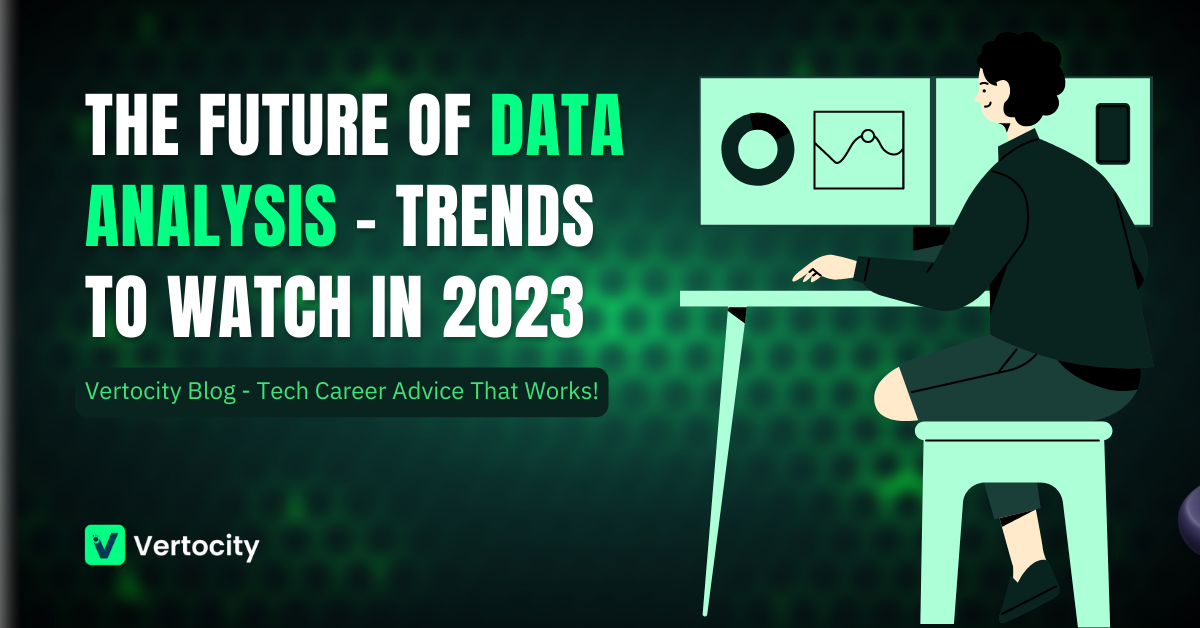In an increasingly data-driven world, the field of data analytics continues to evolve at a rapid pace. As we step into 2023, it’s essential for businesses and professionals to stay informed about the emerging trends shaping the future of data analytics.
In this article, we will explore some of the key developments and trends that are expected to have a significant impact on the data analytics landscape in 2023 and beyond.
The significance of data analysis in the digital era
Data analysis is vital in the digital era for solving business problems, enhancing marketing strategies, and understanding customer demographics. It spans across various industries, from healthcare to real estate. In the past, gathering and analyzing data was time-consuming, but with digital advancements, data can be collected quickly. Data analysis plays a significant role in our world and will continue to grow in importance.
Evolving landscape of data analysis
The landscape of data analysis is constantly evolving. With advancements in technology and the increasing availability of data, the field of data analysis has witnessed significant changes. New tools and techniques have emerged, enabling more efficient data collection, processing, and analysis. The integration of artificial intelligence and machine learning has revolutionized data analysis, enhancing predictive capabilities and unlocking new insights. Data analysts must stay aware of these evolving trends to harness the full potential of data in today’s rapidly changing world.
Importance of staying updated with emerging trends
Data analysis is rapidly evolving, with complex processes and ever-changing tools. Staying updated on trends is crucial. It’s a vital component of business intelligence, uncovering patterns and trends. Data analysis tools sift through data sets, enabling marketing insights and informed decisions. In this article, we explore the future of data analysis, focusing on key tools and emerging trends.
Rise of Artificial Intelligence in Data Analysis
Data analysis is an essential part of the decision-making process for several businesses across the globe. Data analysis AI systems will be able to analyze data just as well as a human and will be able to do it at a much faster rate than a human. This will free up businesses to make more data-based decisions for themselves and their customers.
Integration of AI algorithms in data analysis
AI in data analysis is highly promising, offering faster and more efficient processing. It automates tasks, reducing costs like HR expenses. AI enables Recommendations based on user behavior. Smart chatbots for customer service, sales, and marketing. Predictive analytics forecasting customer behavior and preferences. AI empowers businesses to streamline processes, enhance user experiences, and make data-driven decisions.
Advancements in machine learning and deep learning
Machine learning and deep learning have seen significant advancements. Machine learning algorithms enable systems to learn from data and make predictions or decisions without explicit programming. Deep learning, a subset of machine learning, utilizes artificial neural networks to process and analyze complex data, mimicking human brain functions. These advancements have revolutionized various fields, such as image recognition, natural language processing, and autonomous systems.
You may like this post: Data Analyst Career Paths: Next Steps After Getting Experience!
Automation and Augmentation in Data Analysis
Organizations invest in big data analytics and seek automation and augmentation. Powerful tools like data warehouses and business intelligence platforms simplify analysis. Users desire automation for complex tasks, saving time. They expect tools to identify relevant data, extract insights, and present them visually. Automation streamlines analysis, making it user-friendly and visually appealing.
Streamlining data collection and preprocessing
Efficient data collection, storage, and analysis are crucial for organizations, regardless of their size. To achieve this, companies should focus on streamlining data collection and preprocessing. This involves optimizing the processes of gathering and preparing data for analysis. By ensuring smooth and efficient data collection and preprocessing, organizations can enhance the overall efficiency of their data analytics endeavors.
Automated insights generation
Businesses are amassing vast amounts of data from various sources, allowing for better decision-making and market understanding. Automated insights generation utilizes algorithms and tools to derive actionable insights without manual intervention, saving time and effort. By employing machine learning and natural language processing, organizations extract valuable insights from large datasets, enhancing efficiency and scalability. This empowers data-driven decision-making, improving products, services, and overall business performance.
Advancements in Big Data Analytics
The real-world applications of big data continue to expand rapidly, and its future impact on our lives is even more promising. As we enter an era of continuous connectivity and exponential data growth, businesses are beginning to rely on big data analytics to make decisions that will have a noticeable impact on the world. Like any other emerging technology, big data analytics has its own set of challenges.
Scalable infrastructure for handling massive datasets
At present, most data analysis is done by single servers or small clusters of servers. An alternative is to allow very large datasets to be split into smaller chunks, each of which is analyzed independently. This approach is called parallel processing, and it can be done in several different ways. Data can be split among multiple processors on a single computer, or among multiple computers connected over a network. Parallel processing can be used with nearly any type of data analysis, but it is especially effective for problems that can be divided into independent parts, such as the creation of individual statistical models.
Real-time and near-real-time analytics
Businesses are beginning to shift their focus to real-time and near-real-time analytics. They’re moving away from data analysis and business intelligence (BI) and toward real-time and near-real-time analytics. Real-time analytics helps businesses make decisions in just minutes. Near-real-time analytics delivers quicker insights than real-time. Businesses can use real-time data to: Identify and respond to problems on a large scale, like product quality issues.
Data Privacy and Security
Data privacy and security is a major concern. The growing demand for Big Data has created a surge in new technological innovations and has allowed companies to store and process large amounts of data. Nevertheless, the rise of Big Data has also led to an increase in cybercrime and cyber attacks, as well as to a surge in personal information and privacy rights. The data protection and security market is becoming increasingly complex, leaving businesses in a difficult situation.
Growing concerns and compliance with regulations
In today’s evolving landscape, organizations face increasing regulations and accountability regarding privacy and data. The vast amount of data being collected and analyzed across various platforms necessitates a strategic approach to managing risks. Data analysis plays a vital role in providing insights into customer behavior, optimizing operations, enhancing marketing strategies, and ensuring compliance with regulations. By leveraging data analysis effectively, organizations can make informed decisions, improve customer experiences, and navigate the complexities of the modern data-driven world.
Robust security measures for data protection
Robust security measures, including encryption, firewalls, and strict access controls, are crucial for data protection. Regular audits, backups, and incident response ensure resilience. AI and machine learning enable efficient data analysis, but cost and resource limitations hinder widespread adoption. As companies integrate advanced analysis programs, a strong security system becomes essential for safeguarding valuable data.
Explainable AI in Data Analysis
Explainable AI is crucial in complex and sensitive data analysis domains, ensuring transparency and interpretability in decision-making. As AI adoption grows, the need for understanding how AI models generate conclusions becomes paramount. By addressing the “black box” problem, explainable AI fosters accountability and trust. By balancing interpretability with performance, organizations can make informed decisions and effectively communicate rationale. Despite AI advancements, challenges persist in explaining and interpreting AI systems.
Addressing the “black box” problem
Data analytics is crucial for modern businesses, but the “black box” problem hinders effective utilization. Machine learning, an AI concept, addresses this by understanding data patterns and making intelligent predictions. Companies can leverage data analytics to personalize products and forecast consumer behavior. This trend will likely continue, empowering businesses to solve unforeseen challenges and revolutionize their approach to marketing and sales.
Balancing interpretability and performance
The future of data analysis is not only highly interpretable but also highly performant. Predictive models play a major role in the data science industry, and they must be both interpretable and highly performant. This means that anyone who can interpret the models should be able to understand why a model made certain predictions, and the model should be able to predict with high accuracy. When models are both interpretable and performant, they can be used in any industry.
Edge Computing and IoT in Data Analysis
Edge computing and the Internet of Things (IoT) are revolutionizing data analysis by bringing it closer to the source. As data is generated at the edge, analyzing it in the cloud can be time-consuming. Leveraging edge computing, data is processed and analyzed near its origin, reducing latency and bandwidth requirements. This paradigm shift allows for real-time and localized data analysis, enhancing efficiency and enabling businesses to extract valuable insights directly from IoT devices, transforming industries across the board.
Harnessing the power of edge devices
Edge devices will be pivotal in the future of data analysis. As data generation increases at the edge, it becomes crucial to analyze this data efficiently. Edge devices encompass not only sensors but also web and mobile apps, and database servers. Recognizing the significance of edge devices in data analysis is essential, as they hold immense potential for extracting valuable insights and driving informed decision-making.
Impact of IoT-generated data on the analysis
The IoT generates vast amounts of data from connected devices, presenting valuable resources for data analysis. This data can be categorized into three types: real-time streaming data, device-based data, and user-based data. To effectively handle this data influx, companies are building a scalable infrastructure capable of managing the high volume of IoT-generated data. Such infrastructure enables efficient processing and analysis of data originating from IoT devices.
Natural Language Processing and Text Analytics
In the past decade, we have seen the rise of the biggest social media platforms like Facebook, Twitter, and Linkedin. These platforms have been using Natural Language Processing (NLP) to understand what their users like and share. They use NLP to understand the meaning of words, intent, and sentiment. They use the same technology to filter spam, detect fake profiles, and even develop chatbots for their users. It has the potential to completely change how we interact with technology.
Analysing unstructured data
Unstructured data presents a challenge in data analysis due to its lack of structure and automated processing difficulties. Rising data volumes require innovative solutions to effectively address this issue. The internet’s evolution has heightened data analysis complexity, demanding continuous efforts to overcome challenges and extract value from unstructured data. Advancements are needed to develop efficient methodologies for unlocking its potential.
Conversational AI and virtual assistants
AI and virtual assistants will transform business decision-making, providing conversational user experiences. Adoption will accelerate, especially in customer service. Virtual assistants will efficiently address user queries, leveraging customer preferences to offer personalized responses. Their intelligent decision-making surpasses current systems, redefining customer interactions. The future holds AI-powered virtual assistants as game-changers in business.
Data Visualization and Storytelling
Data visualization has emerged as a popular way to interpret data. It is used by companies to tell the story behind the data and to bring out a deeper, more meaningful insight than mere numbers. Data visualization is a powerful tool to help you turn your data into information, and information into knowledge and insight.
Importance of effective data visualization
1. Enhanced Understanding: Effective data visualization simplifies complex information, revealing patterns and relationships for deeper comprehension.
2. Improved Communication: Visualizing data concisely enables clear communication, facilitating better decision-making and collaboration.
3. Increased Engagement: Engaging visualizations capture attention, making data more memorable and encouraging further exploration.
4. Facilitates Data-Driven Decision Making: Data visualization enables quick identification of trends and patterns, empowering informed choices and actions based on reliable insights.
Storytelling through data insights
Data has become a powerful storytelling tool, but transforming it into a clear narrative can be challenging. However, using storytelling to present data insights is the future of data analysis. With the abundance of unorganized data on the internet, effective storytelling helps us make sense of the vast information available. This trend of using storytelling as a means of conveying data insights is already gaining momentum and is set to continue growing.
Future Challenges and Opportunities in Data Analysis
The future of data analysis is rife with technological and analytical challenges that will continue to affect the work of data analysts. These challenges range from the complexity of data sets, the methods used to collect and store data, and the methods used to analyze and communicate meaningful findings. In the coming years, data analysts will experience ongoing changes in how data is collected, stored, and analyzed, resulting in new ways of understanding and communicating their results.
Ethical considerations and bias in algorithms
As AI advances, ethical concerns and biased data sets will gain prominence in data analysis. Our perception and valuation of data will shift. Instead of solely predicting behaviors, future data analysis will focus on learning and understanding the reasons behind behaviors. This will be crucial as algorithms grow more intricate, necessitating a deeper comprehension of the underlying factors driving data patterns. Keep in mind that the development of AI is not always controlled by humans, but also by the way their algorithms react to certain data.
Skill Sets and training for the future data analyst
The future of data analysis is shaping up to be exciting, dynamic and rewarding. Data science is a constantly evolving field, with new technologies and methodologies appearing regularly.
1. Strong Analytical Skills: Future data analysts need a solid foundation in analytical techniques and statistical methods to effectively analyze and interpret data.
2. Programming and Data Manipulation Skills: Proficiency in programming languages such as Python or R is essential for data manipulation, data cleaning, and building analytical models.
3. Data Visualization Skills: The ability to visually represent data through charts, graphs, and dashboards is crucial for effectively communicating insights to stakeholders.
4. Machine Learning and AI Knowledge: Familiarity with machine learning algorithms and artificial intelligence techniques enables data analysts to leverage advanced tools for predictive modeling and pattern recognition.
If you enjoyed this post, you may also like: Vertocity Data Analyst Program: Become a Data Analyst with Job Guarantee
In Conclusion
By 2023, we expect data analysis to have become more streamlined and intuitive thanks to AI and ML. We also expect to see businesses and organizations taking advantage of these advances to make smarter decisions.





